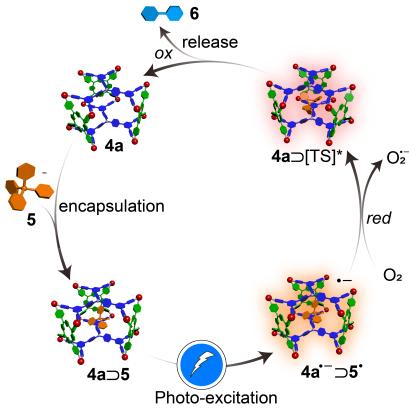Photocatalysis is a promising approach for sustainable chemical synthesis, but its efficiency relies on precise control of electron transfer dynamics—a challenge that natural photosynthesis inspires but artificial systems struggle to replicate. While crystalline frameworks offer ordered structures for directing charge transport, their dense packing limits mass transport and light penetration. Metallacages, with their tunable structures and confined cavities, enhance light harvesting and electron transfer, yet most current designs are homoleptic and lack the functional diversity of heteroleptic assemblies, which could better regulate charge separation and substrate interactions for improved photocatalysis.
To address this bottleneck, Professor Mingming Zhang’s group at the School of Materials Science and Engineering, Xi’an Jiaotong University (XJTU) devised a coordination-driven self-assembly strategy to construct a family of structurally precise porphyrin-based heteroleptic metallacages. Through judicious ligand engineering, Photoactive porphyrin acceptors and electron-rich triphenylamine (TPA) donors were integrated into a single cage framework, enabling directional intramolecular electron transfer within the cage. This heteroleptic design breaks the symmetric charge distribution typical of homoleptic cages, generating a polarized cavity that strengthens host–guest interactions with charged substrates and establishes the prerequisites for directed charge flow.

Theory calculations and ultrafast spectroscopy show that the heteroleptic cage promotes directional electron transfer from TPA donors to porphyrin units, effectively forming a long-lived charge-separated state and markedly enhancing the generation of superoxide radical anions (O₂•⁻) upon irradiation. Harnessing this mechanism, the cage exhibits outstanding catalytic activity in the oxidative coupling of tetraarylborates, achieving up to 99% conversion, far surpassing both the isostructural homoleptic cage and simple physical mixtures—thereby underscoring the advantages of the heteroleptic-ligand strategy. Beyond elucidating the mechanism of directional electron transfer in supramolecular systems, this work establishes a broadly applicable approach to electron-behavior engineering—using “heteroleptic ligand design” to steer charge dynamics and optimize catalytic performance. The strategy provides a blueprint for the development of next-generation, efficient, and selective supramolecular photocatalysts.
This paper entitled “Directional Electron Transfer in Porphyrin-Based Heteroleptic Metallacages for Enhanced Visible-Light–Driven Photocatalysis” was published on Angewandte Chemie International Edition and selected as a Hot Paper. The co–first authors are Dr. Zeyuan Zhang and Zixuan Li at School of Materials Science and Engineering, XJTU. The corresponding authors are Professor Mingming Zhang at School of Materials Science and Engineering, XJTU and Professor Gang He at Frontier Institute of Science and Technology, XJTU. State Key Laboratory for Porous Metal Materials is listed as the primary corresponding affiliation. The research was supported by the National Natural Science Foundation of China, the Shaanxi Provincial Science and Technology Innovation Team program, and related projects. Characterization and testing were carried out at the Analytical & Testing Shared Center of Xi’an Jiaotong University.
Article link: https://onlinelibrary.wiley.com/doi/10.1002/anie.202518798
Professor Mingming Zhang’s homepage: https://gr.xjtu.edu.cn/en/web/mingming.zhang


